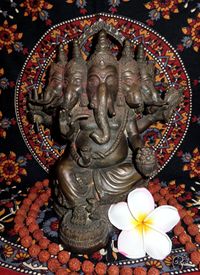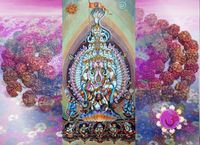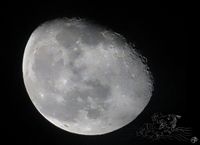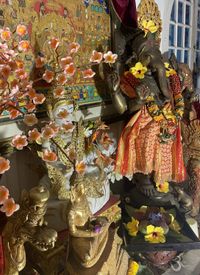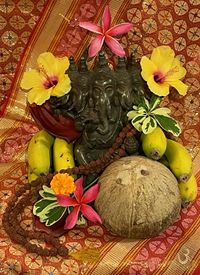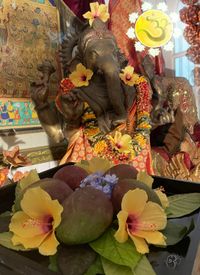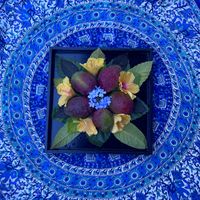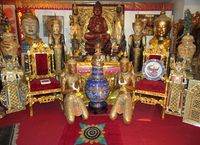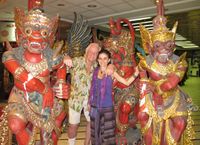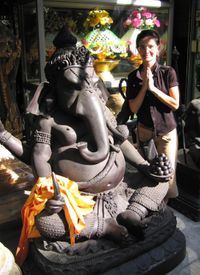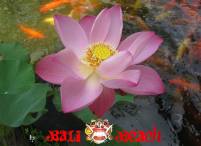ॐ नमो हेरम्ब मद मोदित मम सर्व सङकटं निवारय निवारय हुं पट् स्वाहा।
Om namo heramba, mada modita, mama sarva sankatam nivaraya nivaraya hum pat svaha
Om! Salutations to You, the inspiring and delightful Heramba Ganapati! Kindly destroy all my sorrows and fears.
Heramba Sankashti Ganesha Chaturthi Vrat
Heramba Sankashti Chaturthi is an auspicious Hindu festival that is dedicated to my beloved Ganesha. It is observed on the ‘"Chaturthi" ( means the 4th day) during the dark fortnight of moon of the Hindu month of Bhadrapada (August-September). On this day, devotees worship Ganesha in his form of Heramba Maha Ganapati with full devotion. He has five heads and proportionately, ten arms. "He" indicates "weakness" or "helplessness" and "Ramba" denotes "protection". Heramba Ganapati is thus the compassionate deity who is the protector of the weak and the helpless.
There are 13 Sankashti Chaturthi Vratams (fast days) in the "Ganesha Year". Heramba Sankashti is the last one before the big Ganesha Festival and it is believed that by observing this Vrat all the problems in life will come to an end.
The Legend of Heramba Ganapati Chaturthi
Once upon a time, Vishnu commissioned Brahma to continue creating the world. But Brahma was once again too proud of himself, as was so often the case.
And so it was that Vishnu in his form as Narayana was sleeping on his bed of serpents, when out of his right ear emerged the Asura Madhu; from his left the demon Kaidaba. Asuras are ambitious, jealous and envious creatures, "opponents of beings of light" who oppose the divine order, the Dharma. The two stole the Vedas from Brahma and without the sacred formulas, Brahma could not continue his task as creator. On the other hand, Madhu and Kaidaba grew larger and larger. In their cunning, they tricked the goddess Durga into granting them a wish. So they became (almost) immortal. They could only be destroyed in a world without water, but the oceans already existed on Earth. Madhu and Kaidaba roamed the world torturing all sentient beings. However, this mischief was not enough for them and so they set out for Devaloka, the world of the gods. This place was also destroyed. Then they reached Satyaloka, the place of Brahma, who was already upset because what had happened to him about the Vedas. But he did not want to start a war with the demons and prayed to Vinayaka Ganapati (Ganesha). Through his blessing, it became clear that only Vishnu, the Sustainer of the world, could control the demons. But first he had to be woken up, because he was fast asleep on his snake bed. So Brahma and also Indra ran to Vishnu Narayana with all other gods in their distress. It was a complete mess. Everyone talked at the same time. Brahma asked the gods to be silent and then told Vishnu about the misfortune with the demons.
As the maintainer of the world order, he immediately grabbed his panchajanya (conch) and blew it. It was a war siren. Immediately Madhu and Kaidaba came to him. He immediately went into action with his weapons (chakra, conch, bow and sword). The fight was tough. There was no yielding on either side. Vishnu grew weary after a thousand years of struggle. In desperation he went to the holy Mount Kailash, the dwelling place of Shiva, and told him everything. Shiva immediately recognized the mistake that Vishnu had made, because without the invocation of Ganesha, nothing good could happen. So Shiva said to Vishnu, "Pray to Heramba Ganapati and then restart the war."
Vishnu clasped his hands in prayer and recited a Ganapati mantra. Ganesha appeared before Him and Vishnu said, "How could I forget to honor You before the war begins. Now I know why the result is like this. Please forgive me. Give me strength to defeat the demons". Ganesha in his form as Heramba immediately bestowed blessings on Him. Vishnu knew that he could not defeat Madhu and Kaidaba on earth because it was full of water. Taking the form of the giant Harivamsha, he grabbed the demons, placed the two on his thigh and hit them hard, crushing them in one fell swoop. His hands became coated with the fat of their bodies. He then rubbed the fat off on the ground. The earth became known as Medini because "Medas" means fat in Sanskrit. But it also means vitality, because the two demons were full of energy.
This is of course a very important story and shows how powerful the Heramba Sankashti Day is.
Have you ever seen a Ganesha with five faces? His name is “Panchamukhi Ganapati/Vinayaka” or “Heramba-Ganapati” (in Nepal). “Pancha” means five and “mukhi” are faces. The number five is very significant. We have five senses in our body: sight, smell, touch, taste and hearing, and there are five elements in creation: earth, water, air, fire and ether. There are five senses and five elements, so the “manifested” Divine has five facets. The main meaning for Ganesha’s five heads has another reason. Each head of Panchmukhi Ganesha symbolizes one of the five sheaths in the subtle human anatomy.
1) Annamaya Kosha - This is the sheath that corresponds to our physical body.
2) Pranamaya Kosha - This is the sheath that represents our life energy, the subtle body, nadis and chakras with the Kundalini.
3) Manomaya Kosha - This is the mental sheath that represents the mind and the organs of perception
4) Vijnanamaya Kosha - This is the sheath of wisdom that represents the intellect (Vijnana). With the intellect we distinguish and determine. It is also responsible for doing what we want.
5) Anandamaya Kosha - This is the cosmic sheath of blessing and represents the eternal center of consciousness. Thus the fifth head of Ganesh symbolizes the highest level of yogic experience, also called "Sat-Chit-Ananda", pure consciousness without restriction. Sat-Chit -Ananda, that is true nature. The self is being, wisdom-awareness and bliss, absolute being, infinity and eternity.
Panchamukhi Ganapati is a very powerful form of Ganesha. He plays a major role in the tantric worship of the elephant-headed deity. It is said that he can ward off evil spirits and evil things that happen without one's awareness. Ganesha statues are actually set up facing north. Panchamukhi Vinayaka, however, should face east.
As you know, I don't think so much of simply expressing my wishes and waiting for the happiness of a deity. So I dealt a little more with the five-faced Ganesha and its meaning. I went to the levels of the "sheaths", of his faces.
Why are there sheaths around the self? The “Koshas” determine how your inner light shines outside. At the same time, they also determine how much light, energy and knowledge can get into you.
Annamaya Kosha is the grossest manifestation of Self (Atman). It is our body and it is made up of the five elements that I mentioned at the beginning: earth (Prithivi), water (Apo), fire (Agni), air (Vayu) and ether (Akasha). Kosha is the sheath. Annamaya means something like, made of food. And in fact our body is made of food. Everything you eat becomes Annamaya Kosha. From a spiritual point of view, I therefore find it important to consciously decide which food supports me on the way to "Sat Chit Ananda" and which does not. That is why I have decided on a vegan lifestyle, in which it is also important for me not to necessarily kill plants by eating parts of them. I also eat mainly satvic. Food that is charged with positive energy turns into light. Light that shines in me and maybe also finds its way out (through the body) to allow others to participate. The Annamaya Kosha is a covering through which the soul works, through which the soul can also be known. When you see another person, you first see the Annamaya Kosha. But do not just look at sheath, but through the physical one, through Annamaya Kosha, the soul (Atman), expresses itself, the Divine expresses itself. Ultimately, the physical body is the temple of the soul. It is you own temple and the seat of the divine. And that's exactly what I make myself aware of when I look at the first face of Panchamukhi Ganesha and visualize it.
Pranamaya Kosha is the energy sheath that encloses the five pranas, the life energies (Prana, Apana, Udana, Vyana and Samana). This sheath invigorates the body and mind and is essential for life. In the Pranamaya Kosha there are also the chakras (energy centers) and nadis (energy channels). Prana describes the movement that is directed inwards and downwards, it is the vital force of life. Balanced prana leads to a calm mind and conscious emotions. Apana denotes the movement that takes place outwards and downwards, it is associated with processes of excretion, reproduction and the health of the skeleton (absorption of nutrients). Udana denotes the movement that is directed upwards, it is related to the respiratory functions, language and the function of the brain. Balanced Udana, for example, leads to a healthy respiratory system, clear speech, healthy mind, relaxation and creativity. Udana also helps to fall asleep and to wake up again, also helps to leave the physical body and go on an out of body experience Samana is the energy that spirals, concentrates around the navel. Vyana is the movement that is directed outwards. It is related to the circulatory system, nervous system, and heart system. The goal in life is to bring these five "pranas" into a balanced state, for example through your lifestyle, yoga and meditation. And that's exactly what I make myself aware of when I look at the fsecond face of Panchamukhi Ganesha and visualize it.
Manomaya Kosha is the emotional or mind sheath. It consists of the mind (Manas), the subconscious (Chitta), the five organs of action (Karma Indriya) and the five organs of perception (Jnana Indriya). But it's only one sheath. You are not the Manomaya Kosha, therefore, do not identify with thinking and feeling. It is not you who is emotional, but a state of this kosha. And even if you identify yourself with it for a moment, you can influence your behavior, when you are aware of this "kosha system". For example, you can develop compassion, unconditional love or forgiveness on your Manomaya Kosha. You can develop calm, trust or courage there. You have a certain influence on what becomes strong in the Manomaya Kosha, what properties become active in this sheath. Above all else, you have the opportunity not to identify yourself. Observe, not identify. And that's exactly what I make myself aware of when I look at the third face of Panchamukhi Ganesha and visualize it.
Vijnanamaya Kosha is the sheath made of intelligence. There are two components, there is Buddhi and Ahamkara. Buddhi is knowledge, reason, free will and discernment. Buddhi can compare, go into the past and into the future, can draw conclusions and can also make decisions. Buddhi also means opening up to intuition and divine guidance. A developed Vijnanamaya Kosha is what helps you to advance on the spiritual path and how you can walk a conscious spiritual path at all. Ahamkara is the sense of self. Ahamkara is identification. For example, when you say, "I am so and so" or "I need this or that". Amkara is the knowledge of oneself and the awareness of oneself as a person who is born at some point, will die at some point and who is in exchange with the environment and other living beings. Ahamkara can also be the ego and lead to various problems. And that's exactly what I make myself aware of when I look at the fourth face of Panchamukhi Ganesha and visualize it.
Anandamaya Kosha is difficult to explain because this sheath is beyond our mindset. It is a kind of knowledge, a state of light, of real joy, of true love. In Anandamaya Kosha the mystical experiences are, you feel the divine, you feel what your task is in this life. It is a certainty, not just a gut feeling or an intuition. It’s the hOMe of Sat Chit Ananda! And that's exactly what I make myself aware of when I look at the fifth face of Panchamukhi Ganesha and visualize it.
Om Shree Herambaya Namaha
I would like to explain the rituals to you in a somewhat simplified way, as I perform them myself:
These days are entirely dedicated to the worship of Ganesha.
You start the day by lighting a candle and incense sticks (preferably sandalwood) in front of the statue or the picture of a Ganesha. Recite a Ganesha mantra in Japa form, i.e. at least one cycle of 108 times.
For example the Ganesha Bija Mantra:
"om gam ganapataye namaha"
It's very simple and yet so powerful. I put a lot of emphasis on the emphasis on OM and GAM. Do not forget the "M", because the universe is in this sound!
I pefer the Ganapati Moola Mantra:
OM SHREEM HREEM KLEEM GLAUM GAM GANAPATAYE
VARA VARAD SARVAJANJANMME VAHAMANAYE SWAHA
EKADANTAYA VIDMAHE ~ VAKRATUNDAYA DHEEMAHI
TANNO DANTIH PRACHODAYATH ~ TANNO DANTH PRACHODAYATH
OM SHANTI SHANTI SHANTIHI
We meditate upon Him who has a Curved trunk
We bow before the one with the single-tusked elephant tooth to illuminate our minds with wisdom.”
On this day, you should fast from sunrise until the moon appears in the night sky. If this is not possible for you, try a fruit diet. Or eat sattvic vegetables that grow underground, for example a potato or peanuts, but not bulbs or garlic, they are not sattvic. And do not consume rice, wheat and lentils in any form. Consumption of tobacco and alcohol is strictly prohibited.
The actual "Sankashti Puja" (ceremony) is celebrated in the evening just before seeing the moon. Bring fresh flowers to Ganesha, light another candle and incense sticks (sandalwood).
Ganesha likes "Modaka", which is an Indian dessert made from jaggery, rice flour and fresh coconut flakes. But I'm sure he likes other sweets too! Make something with oure love and give it to him as an offering along with fruit (bananas, don't forget, Ganesha wife is a bana tree in the tradition of South India!)
Recite Vedic Ganesha mantras.
This can be the bija mantras,
om gam ganapataye namaha
Meaning: OM, salutations to the remover of obstacles.
or
om shree ganeshaya namaha
Meaning: OM, Lord Ganesha, I offer prayers to you.
or the Ganapati Gayatri Mantra
OM Ekadantaya Viddhmahe, Vakratundaya Dheemahi Tanno Danti Prachodayat
Meaning: OM, Glory to the one who has one tusk and a curved trunk, I bow before you to get blessed by your grace for an illuminated life.
And that is exactly why the devotee also calls his 108 names on this special Chaturthi!
Ganesha Ashtottara Sata Namavali
ōṃ gaṇādhyakṣāya namaḥ
ōṃ vighnārājāya namaḥ
ōṃ vināyakāya namaḥ
ōṃ dtvemāturāya namaḥ
ōṃ dvimukhāya namaḥ
ōṃ pramukhāya namaḥ
ōṃ sumukhāya namaḥ
ōṃ kṛtinē namaḥ
ōṃ supradīpāya namaḥ
ōṃ sukhanidhayē namaḥ
ōṃ surādhyakṣāya namaḥ
ōṃ surārighnāya namaḥ
ōṃ mahāgaṇapatayē namaḥ
ōṃ mānyāya namaḥ
ōṃ mahākālāya namaḥ
ōṃ mahābalāya namaḥ
ōṃ hērambāya namaḥ
ōṃ lambajaṭharāya namaḥ
ōṃ hrasvagrīvāya namaḥ
ōṃ mahōdarāya namaḥ
ōṃ madōtkaṭāya namaḥ
ōṃ mahāvīrāya namaḥ
ōṃ mantriṇē namaḥ
ōṃ maṅgaḻa svarāya namaḥ
ōṃ pramadhāya namaḥ
ōṃ prathamāya namaḥ
ōṃ prājñāya namaḥ
ōṃ vighnakartrē namaḥ
ōṃ vighnahantrē namaḥ
ōṃ viśvanētrē namaḥ
ōṃ virāṭpatayē namaḥ
ōṃ śrīpatayē namaḥ
ōṃ vākpatayē namaḥ
ōṃ śṛṅgāriṇē namaḥ
ōṃ āśrita vatsalāya namaḥ
ōṃ śivapriyāya namaḥ
ōṃ śīghrakāriṇē namaḥ
ōṃ śāśvatāya namaḥ
ōṃ balāya namaḥ
ōṃ balōtthitāya namaḥ
ōṃ bhavātmajāya namaḥ
ōṃ purāṇa puruṣāya namaḥ
ōṃ pūṣṇē namaḥ
ōṃ puṣkarōtṣipta vāriṇē namaḥ
ōṃ agragaṇyāya namaḥ
ōṃ agrapūjyāya namaḥ
ōṃ agragāminē namaḥ
ōṃ mantrakṛtē namaḥ
ōṃ chāmīkara prabhāya namaḥ
ōṃ sarvāya namaḥ
ōṃ sarvōpāsyāya namaḥ
ōṃ sarva kartrē namaḥ
ōṃ sarvanētrē namaḥ
ōṃ sarvasidhdhi pradāya namaḥ
ōṃ sarva siddhayē namaḥ
ōṃ pañchahastāya namaḥ
ōṃ pārvatīnandanāya namaḥ
ōṃ prabhavē namaḥ
ōṃ kumāra guravē namaḥ
ōṃ akṣōbhyāya namaḥ
ōṃ kuñjarāsura bhañjanāya namaḥ
ōṃ pramōdāya namaḥ
ōṃ mōdakapriyāya namaḥ
ōṃ kāntimatē namaḥ
ōṃ dhṛtimatē namaḥ
ōṃ kāminē namaḥ
ōṃ kapitthavanapriyāya namaḥ
ōṃ brahmachāriṇē namaḥ
ōṃ brahmarūpiṇē namaḥ
ōṃ brahmavidyādi dānabhuvē namaḥ
ōṃ jiṣṇavē namaḥ
ōṃ viṣṇupriyāya namaḥ
ōṃ bhakta jīvitāya namaḥ
ōṃ jita manmathāya namaḥ
ōṃ aiśvarya kāraṇāya namaḥ
ōṃ jyāyasē namaḥ
ōṃ yakṣakinnera sēvitāya namaḥ
ōṃ gaṅgā sutāya namaḥ
ōṃ gaṇādhīśāya namaḥ
ōṃ gambhīra ninadāya namaḥ
ōṃ vaṭavē namaḥ
ōṃ abhīṣṭa varadāyinē namaḥ
ōṃ jyōtiṣē namaḥ
ōṃ bhakta nidhayē namaḥ
ōṃ bhāvagamyāya namaḥ
ōṃ maṅgaḻa pradāya namaḥ
ōṃ avvaktāya namaḥ
ōṃ aprākṛta parākramāya namaḥ
ōṃ satyadharmiṇē namaḥ
ōṃ sakhayē namaḥ
ōṃ sarasāmbu nidhayē namaḥ
ōṃ mahēśāya namaḥ
ōṃ divyāṅgāya namaḥ
ōṃ maṇikiṅkiṇī mēkhālāya namaḥ
ōṃ samastadēvatā mūrtayē namaḥ
ōṃ sahiṣṇavē namaḥ
ōṃ satatōtthitāya namaḥ
ōṃ vighāta kāriṇē namaḥ
ōṃ viśvagdṛśē namaḥ
ōṃ viśvarakṣākṛtē namaḥ
ōṃ kaḻyāṇa guravē namaḥ
ōṃ unmatta vēṣāya namaḥ
ōṃ aparājitē namaḥ
ōṃ samasta jagadādhārāya namaḥ
ōṃ sartveśvaryapradāya namaḥ
ōṃ ākrānta chidachitprabhavē namaḥ
ōṃ śrī vighnēśvarāya namaḥ
Also think of the moon, because the divine dwells in it too. I always have water in a sacred vessel on my Shiva altar. "Tirtha", holy water, that's how I know it from Bali. Spray this water towards the moon and recite a mantra in honor of the divine moon.
When you see the rising moon you can break the fast. Now you can eat yourself the offerings that you gave to Ganesha. It is now sacred "Prasad". It has a very different energy than normal food!
Ganesha is the formless energy from which everything manifests and into which everything will dissolve.
Ganesh is the embodiment of spirituality, prosperity, wisdom and consciousness.
In difficult times as we have been experiencing for a year, Ganesha can awaken a different perspective in us.
He can open new doors for us. New ways.
Everything should start with Ganesha.
Every mantra, every ceremony, everything we do.
Liberate from old views in order to be open to new ideas.
Free from prejudice, free from patterns that only hinder us.
The holy fast, or partial fasting, can help.
When I recite a Ganesha mantra
before starting anything, I say to myself:
In what I am about to do, let wisdom be my guide".
ॐOm Gam Ganapataye Namahaॐ
Be aware, that Ganesha is in everybody of us, in every atom of the universe.
Heramba Sankasthi Chaturthi 2022
Be aware, that Ganesha is in everybody of us, in every atom of the universe.

